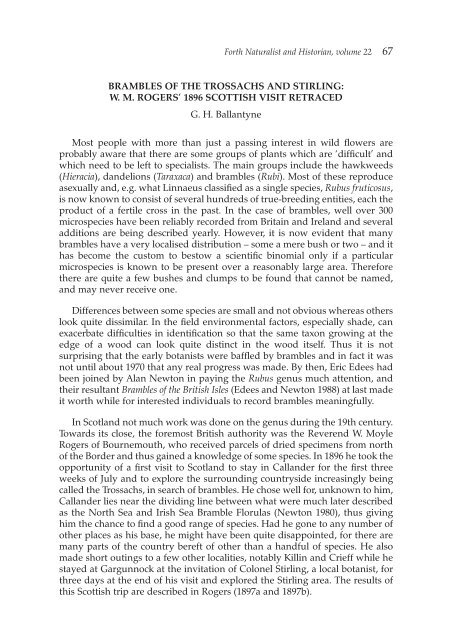the Forth Naturalist Historian - Forth Naturalist and Historian ...
the Forth Naturalist Historian - Forth Naturalist and Historian ...
the Forth Naturalist Historian - Forth Naturalist and Historian ...
Create successful ePaper yourself
Turn your PDF publications into a flip-book with our unique Google optimized e-Paper software.
<strong>Forth</strong> <strong>Naturalist</strong> <strong>and</strong> <strong>Historian</strong>, volume 22 67<br />
BRAMBLES OF THE TROSSACHS AND STIRLING:<br />
W. M. ROGERS’ 1896 SCOTTISH VISIT RETRACED<br />
G. H. Ballantyne<br />
Most people with more than just a passing interest in wild flowers are<br />
probably aware that <strong>the</strong>re are some groups of plants which are ‘difficult’ <strong>and</strong><br />
which need to be left to specialists. The main groups include <strong>the</strong> hawkweeds<br />
(Hieracia), d<strong>and</strong>elions (Taraxaca) <strong>and</strong> brambles (Rubi). Most of <strong>the</strong>se reproduce<br />
asexually <strong>and</strong>, e.g. what Linnaeus classified as a single species, Rubus fruticosus,<br />
is now known to consist of several hundreds of true-breeding entities, each <strong>the</strong><br />
product of a fertile cross in <strong>the</strong> past. In <strong>the</strong> case of brambles, well over 300<br />
microspecies have been reliably recorded from Britain <strong>and</strong> Irel<strong>and</strong> <strong>and</strong> several<br />
additions are being described yearly. However, it is now evident that many<br />
brambles have a very localised distribution – some a mere bush or two – <strong>and</strong> it<br />
has become <strong>the</strong> custom to bestow a scientific binomial only if a particular<br />
microspecies is known to be present over a reasonably large area. Therefore<br />
<strong>the</strong>re are quite a few bushes <strong>and</strong> clumps to be found that cannot be named,<br />
<strong>and</strong> may never receive one.<br />
Differences between some species are small <strong>and</strong> not obvious whereas o<strong>the</strong>rs<br />
look quite dissimilar. In <strong>the</strong> field environmental factors, especially shade, can<br />
exacerbate difficulties in identification so that <strong>the</strong> same taxon growing at <strong>the</strong><br />
edge of a wood can look quite distinct in <strong>the</strong> wood itself. Thus it is not<br />
surprising that <strong>the</strong> early botanists were baffled by brambles <strong>and</strong> in fact it was<br />
not until about 1970 that any real progress was made. By <strong>the</strong>n, Eric Edees had<br />
been joined by Alan Newton in paying <strong>the</strong> Rubus genus much attention, <strong>and</strong><br />
<strong>the</strong>ir resultant Brambles of <strong>the</strong> British Isles (Edees <strong>and</strong> Newton 1988) at last made<br />
it worth while for interested individuals to record brambles meaningfully.<br />
In Scotl<strong>and</strong> not much work was done on <strong>the</strong> genus during <strong>the</strong> 19th century.<br />
Towards its close, <strong>the</strong> foremost British authority was <strong>the</strong> Reverend W. Moyle<br />
Rogers of Bournemouth, who received parcels of dried specimens from north<br />
of <strong>the</strong> Border <strong>and</strong> thus gained a knowledge of some species. In 1896 he took <strong>the</strong><br />
opportunity of a first visit to Scotl<strong>and</strong> to stay in Call<strong>and</strong>er for <strong>the</strong> first three<br />
weeks of July <strong>and</strong> to explore <strong>the</strong> surrounding countryside increasingly being<br />
called <strong>the</strong> Trossachs, in search of brambles. He chose well for, unknown to him,<br />
Call<strong>and</strong>er lies near <strong>the</strong> dividing line between what were much later described<br />
as <strong>the</strong> North Sea <strong>and</strong> Irish Sea Bramble Florulas (Newton 1980), thus giving<br />
him <strong>the</strong> chance to find a good range of species. Had he gone to any number of<br />
o<strong>the</strong>r places as his base, he might have been quite disappointed, for <strong>the</strong>re are<br />
many parts of <strong>the</strong> country bereft of o<strong>the</strong>r than a h<strong>and</strong>ful of species. He also<br />
made short outings to a few o<strong>the</strong>r localities, notably Killin <strong>and</strong> Crieff while he<br />
stayed at Gargunnock at <strong>the</strong> invitation of Colonel Stirling, a local botanist, for<br />
three days at <strong>the</strong> end of his visit <strong>and</strong> explored <strong>the</strong> Stirling area. The results of<br />
this Scottish trip are described in Rogers (1897a <strong>and</strong> 1897b).



